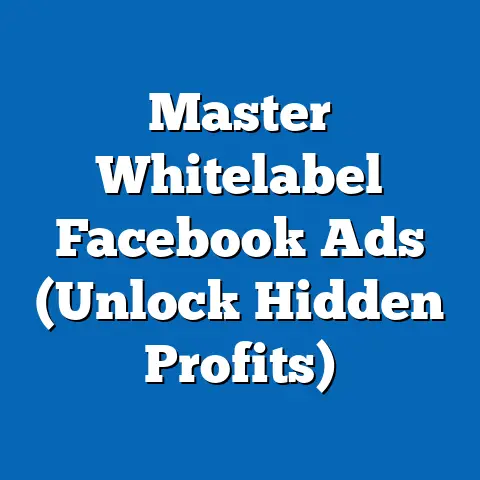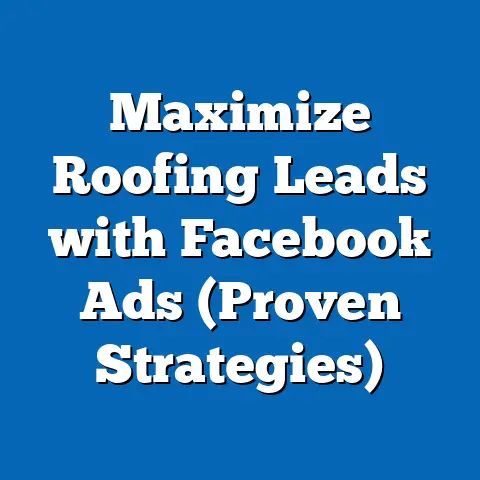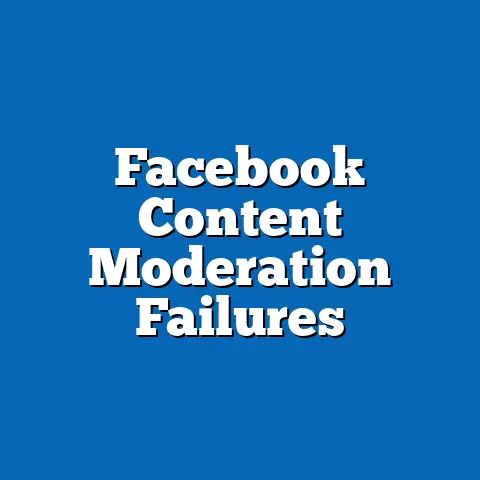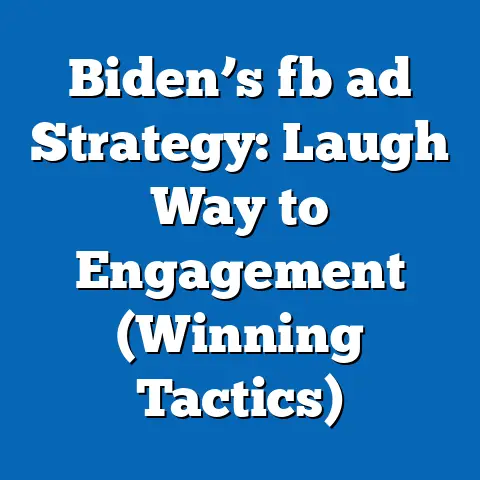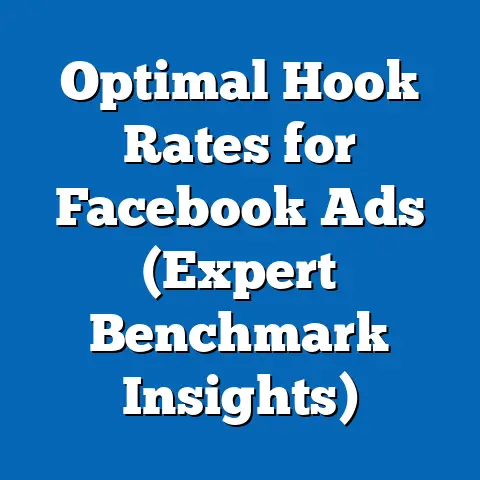Craft Facebook Ad Copy Like a Pro (Expert Strategies Revealed)
In the ever-evolving world of Facebook advertising, where users are bombarded with countless ads daily, standing out from the crowd is no longer a luxury—it’s a necessity. I’ve seen firsthand how a well-crafted ad can transform a struggling campaign into a roaring success. It’s not just about having a great product or service; it’s about communicating its value in a way that resonates deeply with your audience. This is where the art of crafting compelling ad copy comes into play. Think of it as painting a picture with words, using the right textures to evoke feelings and create a lasting impression.
Imagine scrolling through your Facebook feed and being instantly captivated by an ad that speaks directly to your needs, desires, and aspirations. What makes that ad so compelling? It’s not just luck; it’s the result of strategic copywriting that understands the power of connection. In this guide, I’m going to pull back the curtain and reveal expert strategies for crafting Facebook ad copy that not only grabs attention but also drives conversions. We’ll dive into the concept of “textures” in ad copy—how the right choice of words creates a vivid, emotional experience for the reader. Get ready to transform your Facebook ads from ordinary to extraordinary!
Section 1: Understanding Your Audience
Before you even think about writing a single word, it’s crucial to understand who you’re talking to. I’ve learned this the hard way, launching campaigns that fell flat simply because I hadn’t taken the time to truly understand my audience. It’s like trying to sell snow to Eskimos – you need to know their needs and desires before you can offer a solution.
So, how do you get to know your audience? Start with audience research.
-
Demographics: This is the basic stuff – age, gender, location, education, job title, etc. Facebook Audience Insights can be a goldmine for this information.
-
Interests: What are they passionate about? What pages do they like? What groups are they a part of? Again, Facebook Audience Insights is your friend here.
-
Pain Points: What problems are they facing? What are their frustrations? This is where you need to dig a little deeper. Read reviews of your competitors, monitor social media conversations, and conduct surveys to uncover their pain points.
-
Language: How do they speak? What kind of language do they use? Are they formal or informal? Use their language in your ad copy to build trust and rapport.
Demographics: This is the basic stuff – age, gender, location, education, job title, etc. Facebook Audience Insights can be a goldmine for this information.
Interests: What are they passionate about? What pages do they like? What groups are they a part of? Again, Facebook Audience Insights is your friend here.
Pain Points: What problems are they facing? What are their frustrations? This is where you need to dig a little deeper. Read reviews of your competitors, monitor social media conversations, and conduct surveys to uncover their pain points.
Language: How do they speak? What kind of language do they use? Are they formal or informal? Use their language in your ad copy to build trust and rapport.
Understanding these elements allows you to craft copy that resonates emotionally, using textures that speak directly to your audience’s desires and challenges. For example, if you’re targeting young professionals struggling with student loan debt, you might use textures of hope, freedom, and financial security. On the other hand, if you’re targeting busy parents, you might use textures of convenience, time-saving, and peace of mind.
Example:
- Audience Segment: Young professionals (25-35) struggling with student loan debt.
- Desired Texture: Hope, freedom, financial security.
- Ad Copy Snippet: “Tired of being weighed down by student loan debt? Imagine a future where you’re free to pursue your dreams without the burden of monthly payments. Our proven strategies can help you pay off your loans faster and achieve financial freedom. Start your journey to a debt-free life today!”
Key Takeaway: Thorough audience research is the foundation of effective ad copy. Understand their demographics, interests, pain points, and language to create copy that resonates emotionally and drives action.
Section 2: The Power of Emotion in Ad Copy
Humans are emotional beings, and our decisions are often driven by feelings rather than logic. I’ve seen this time and time again in my own campaigns – ads that tap into emotions consistently outperform those that simply list features and benefits. Think about it: Do you remember the last time you bought something purely based on rational analysis? Probably not. There was likely an emotional element involved, whether it was the desire for status, the fear of missing out, or the joy of owning something beautiful.
Here are some specific emotions and how they can be woven into the textures of your copy:
-
Fear: This can be a powerful motivator, but use it ethically. Highlight the potential consequences of not using your product or service. For example, an insurance company might use fear to emphasize the importance of protecting your family.
-
Joy: Evoke feelings of happiness, excitement, and pleasure. Show how your product or service can bring joy to your customers’ lives. For example, a travel agency might use joy to showcase the excitement of exploring new destinations.
-
Trust: Build credibility and establish yourself as a reliable source of information. Use testimonials, social proof, and guarantees to build trust. For example, a financial advisor might use trust to reassure potential clients that their money is in safe hands.
-
Curiosity: Intrigue your audience and make them want to learn more. Use questions, teasers, and unexpected statements to spark curiosity. For example, a marketing agency might use curiosity to pique interest in their services.
-
Belonging: Make your audience feel like they’re part of a community. Show how your product or service can help them connect with others who share their interests and values. For example, a fitness brand might use belonging to create a sense of community among its members.
Fear: This can be a powerful motivator, but use it ethically. Highlight the potential consequences of not using your product or service. For example, an insurance company might use fear to emphasize the importance of protecting your family.
Joy: Evoke feelings of happiness, excitement, and pleasure. Show how your product or service can bring joy to your customers’ lives. For example, a travel agency might use joy to showcase the excitement of exploring new destinations.
Trust: Build credibility and establish yourself as a reliable source of information. Use testimonials, social proof, and guarantees to build trust. For example, a financial advisor might use trust to reassure potential clients that their money is in safe hands.
Curiosity: Intrigue your audience and make them want to learn more. Use questions, teasers, and unexpected statements to spark curiosity. For example, a marketing agency might use curiosity to pique interest in their services.
Belonging: Make your audience feel like they’re part of a community. Show how your product or service can help them connect with others who share their interests and values. For example, a fitness brand might use belonging to create a sense of community among its members.
Example:
- Emotion: Joy
- Desired Texture: Happiness, excitement, pleasure
- Ad Copy Snippet: “Imagine yourself basking in the sun on a pristine beach, sipping a refreshing cocktail, and listening to the gentle sound of the waves. Our exclusive vacation packages can make your dream a reality. Book your escape today and create memories that will last a lifetime!”
I remember working on a campaign for a local bakery. Instead of just listing their products (“delicious cakes and pastries!”), we focused on the emotions associated with their treats. We used images of smiling families sharing a cake, and our copy evoked feelings of warmth, nostalgia, and celebration. The result? A significant increase in sales and a stronger connection with their local community.
Key Takeaway: Tap into the power of emotion in your ad copy. Identify the emotions that resonate with your audience and weave them into the textures of your copy to create a deeper connection and drive action.
Section 3: Crafting Compelling Headlines
Your headline is the first (and sometimes only) chance you have to grab someone’s attention in the crowded Facebook feed. I’ve learned that a mediocre headline can doom even the most well-crafted ad copy. Think of it as the storefront of your ad – it needs to be eye-catching and intriguing enough to entice people to step inside.
Here are some strategies for creating eye-catching headlines that incorporate sensory textures:
-
Use Power Words: These are words that evoke emotion and create a strong impact. Examples include “amazing,” “secret,” “proven,” “guaranteed,” and “exclusive.”
-
Incorporate Numbers: Numbers are naturally attention-grabbing and can add credibility to your claims. Examples include “5 Proven Ways to Lose Weight,” “The 3 Biggest Mistakes You’re Making with Your Finances,” and “10 Secrets to a Successful Marriage.”
-
Ask a Question: Questions can pique curiosity and encourage engagement. Examples include “Are You Ready to Finally Achieve Your Dreams?” “Tired of Feeling Stressed and Overwhelmed?” and “Want to Learn the Secret to a Happy Life?”
-
Create Urgency: Use language that creates a sense of urgency and encourages immediate action. Examples include “Limited Time Offer,” “Don’t Miss Out,” and “Act Now Before It’s Too Late.”
Use Power Words: These are words that evoke emotion and create a strong impact. Examples include “amazing,” “secret,” “proven,” “guaranteed,” and “exclusive.”
Incorporate Numbers: Numbers are naturally attention-grabbing and can add credibility to your claims. Examples include “5 Proven Ways to Lose Weight,” “The 3 Biggest Mistakes You’re Making with Your Finances,” and “10 Secrets to a Successful Marriage.”
Ask a Question: Questions can pique curiosity and encourage engagement. Examples include “Are You Ready to Finally Achieve Your Dreams?” “Tired of Feeling Stressed and Overwhelmed?” and “Want to Learn the Secret to a Happy Life?”
Create Urgency: Use language that creates a sense of urgency and encourages immediate action. Examples include “Limited Time Offer,” “Don’t Miss Out,” and “Act Now Before It’s Too Late.”
Example:
- Headline: “Secret Weapon Unlocks Your Dream Life: [Company Name]”
- Breakdown:
- “Secret Weapon”: Creates curiosity and intrigue.
- “Unlocks Your Dream Life”: Evokes emotion and promises a desirable outcome.
- “[Company Name]”: Adds credibility and provides a clear call to action.
- “Secret Weapon”: Creates curiosity and intrigue.
- “Unlocks Your Dream Life”: Evokes emotion and promises a desirable outcome.
- “[Company Name]”: Adds credibility and provides a clear call to action.
I once worked on a campaign for a software company that was struggling to generate leads. Their original headline was bland and uninspiring: “Software for Business Management.” We completely revamped it using power words and a question: “Is Your Business Drowning in Chaos? Our Secret Weapon Can Help!” The results were dramatic – a 300% increase in lead generation.
Key Takeaway: Your headline is your first impression. Use power words, numbers, questions, and urgency to create eye-catching headlines that grab attention and entice people to click.
Section 4: Writing Persuasive Body Copy
Once you’ve hooked your audience with a compelling headline, it’s crucial to maintain their interest and encourage them to take action with persuasive body copy. I’ve found that the key is to continue the textures established in the headline and provide valuable information that addresses their needs and desires.
Here are some techniques for writing persuasive body copy that maintains interest and encourages action:
-
Use Bullet Points: Break up large blocks of text and make your copy easier to read. Highlight key benefits and features using bullet points.
-
Tell a Story: Stories are naturally engaging and can help you connect with your audience on an emotional level. Share a personal anecdote, a customer success story, or a case study to illustrate the value of your product or service.
-
Provide Social Proof: Use testimonials, reviews, and case studies to build credibility and demonstrate the value of your product or service.
-
Include a Clear Call-to-Action (CTA): Tell your audience exactly what you want them to do. Use strong action verbs like “Shop Now,” “Learn More,” “Get Started,” and “Download Now.”
-
Address Objections: Anticipate and address potential objections that your audience might have. For example, if you’re selling a high-priced product, you might address concerns about affordability by offering financing options or highlighting the long-term value.
Use Bullet Points: Break up large blocks of text and make your copy easier to read. Highlight key benefits and features using bullet points.
Tell a Story: Stories are naturally engaging and can help you connect with your audience on an emotional level. Share a personal anecdote, a customer success story, or a case study to illustrate the value of your product or service.
Provide Social Proof: Use testimonials, reviews, and case studies to build credibility and demonstrate the value of your product or service.
Include a Clear Call-to-Action (CTA): Tell your audience exactly what you want them to do. Use strong action verbs like “Shop Now,” “Learn More,” “Get Started,” and “Download Now.”
Address Objections: Anticipate and address potential objections that your audience might have. For example, if you’re selling a high-priced product, you might address concerns about affordability by offering financing options or highlighting the long-term value.
Example:
- Headline: “Tired of Feeling Stressed and Overwhelmed?”
- Body Copy:
- “Imagine a life where you’re calm, focused, and in control.”
- “Our proven system can help you reduce stress, improve productivity, and achieve your goals.”
- “Here’s what you’ll get:”
- “Step-by-step guidance to manage your time effectively.”
- “Powerful techniques to overcome procrastination.”
- “A supportive community of like-minded individuals.”
- “Join our program today and start living a more fulfilling life!”
- CTA: “Learn More”
- “Imagine a life where you’re calm, focused, and in control.”
- “Our proven system can help you reduce stress, improve productivity, and achieve your goals.”
- “Here’s what you’ll get:”
- “Step-by-step guidance to manage your time effectively.”
- “Powerful techniques to overcome procrastination.”
- “A supportive community of like-minded individuals.”
- “Join our program today and start living a more fulfilling life!”
- CTA: “Learn More”
- “Step-by-step guidance to manage your time effectively.”
- “Powerful techniques to overcome procrastination.”
- “A supportive community of like-minded individuals.”
I remember working with a client who was struggling to convert leads into customers. Their body copy was dry and technical, focusing on features rather than benefits. We completely rewrote it, focusing on the emotional benefits of their product and telling compelling customer success stories. The result? A significant increase in conversion rates.
Key Takeaway: Your body copy should maintain the textures established in the headline, provide valuable information, and encourage action. Use bullet points, storytelling, social proof, a clear CTA, and address potential objections to maximize your impact.
Section 5: The Role of Visuals in Enhancing Textures
Visuals are an integral part of Facebook advertising, and they can significantly enhance the textures of your ad copy. I’ve learned that the right image or video can amplify the emotional impact of your message and make your ad even more compelling.
The synergy between text and images is crucial. Certain textures in copy can be supported by visual elements. For example, if your ad copy evokes feelings of luxury and sophistication, your visuals should reflect that with high-quality images of elegant products or settings. On the other hand, if your ad copy evokes feelings of fun and excitement, your visuals should be playful and energetic.
Here are some tips for selecting images that resonate with the emotional tone of your ad:
-
Use High-Quality Images: Avoid blurry or pixelated images. Use professional-quality photos or videos that are visually appealing and capture the attention of your audience.
-
Choose Relevant Images: Your images should be relevant to your product or service and the message you’re trying to convey.
-
Show People Using Your Product: Images of people using your product or service can help your audience visualize themselves doing the same.
-
Use Emotionally Evocative Images: Choose images that evoke the emotions you want your audience to feel. For example, if you’re selling travel packages, use images of happy people enjoying themselves in exotic locations.
Use High-Quality Images: Avoid blurry or pixelated images. Use professional-quality photos or videos that are visually appealing and capture the attention of your audience.
Choose Relevant Images: Your images should be relevant to your product or service and the message you’re trying to convey.
Show People Using Your Product: Images of people using your product or service can help your audience visualize themselves doing the same.
Use Emotionally Evocative Images: Choose images that evoke the emotions you want your audience to feel. For example, if you’re selling travel packages, use images of happy people enjoying themselves in exotic locations.
Example:
- Ad Copy: “Escape the Ordinary and Discover Paradise”
- Visual: A stunning image of a tropical beach with crystal-clear water and white sand.
I once worked on a campaign for a real estate agency that was struggling to generate leads for their luxury properties. Their original ads used generic images of houses that didn’t stand out. We replaced them with stunning images of the interiors and exteriors of the properties, showcasing their unique features and luxurious amenities. The result? A significant increase in leads and sales.
Key Takeaway: Visuals are an essential part of Facebook advertising. Choose high-quality, relevant, and emotionally evocative images that complement your ad copy and enhance the overall message.
Conclusion
Crafting Facebook ad copy that stands out in today’s crowded digital landscape requires a strategic approach. I’ve shared with you the importance of understanding your audience, tapping into the power of emotion, crafting compelling headlines, writing persuasive body copy, and using visuals to enhance the textures of your message. Mastering these techniques can elevate your ad’s effectiveness and connect with your audience on a personal level.
Remember, the key is to experiment and find what works best for your specific audience and product or service. Don’t be afraid to try new things and track your results to see what resonates.
Call to Action
Now it’s your turn! Take these strategies and apply them to your next Facebook ad campaign. Experiment with different textures, headlines, and visuals to see what works best for you. Share your experiences and results in the comments below or on social media. Let’s learn from each other and create a community of successful Facebook advertisers!
For more insights into effective Facebook advertising strategies, subscribe to my newsletter or follow my page. I’m constantly sharing new tips, tricks, and case studies to help you achieve your advertising goals. Let’s connect and take your Facebook ads to the next level!

